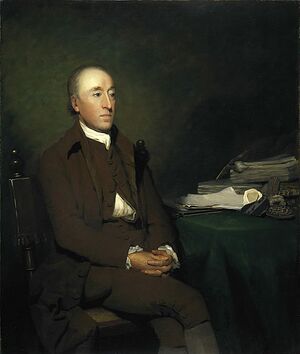جيمس هتون
جيمس هَتونْ James Hutton FRSE (عاش إدنبرة، 3 يونيو 1726 نق (14 June 1726 نح) - 26 مارس 1797) طبيب وجيولوجي وطبيعي وصانع كيميائي ومزارع تجريبي اسكتلندي.[1] ذاعت شهرته بسبب نظريته حول أصل الكرة الأرضية. وهو يُلقب بأبي الجيولوجيا الحديثة.
جيمس هتون James Hutton | |
|---|---|
 هتن كما رسمه السير هنري ريبيرن | |
| وُلِدَ | 14 June 1726 |
| توفي | 26 March 1797 |
| الجنسية | اسكتلندي |
| اللقب | Plutonic geology الزمن السحيق Deep time |
| السيرة العلمية | |
| المجالات | جيولوجيا |
اقترح هتون مبدأ الانتظام "نظرية الأرض" (1785). وقد أكد على أن العمليات الجيولوجية المُختبرة في زمنه تشرح تشكل الصخور الأقدم. وقد تزعم جون پلايفير المنادين بنظرية هتن. وفعلياً كان هتن مؤسس الجيولوجيا الحديثة، مبدلاً الإيمان بدور الطوفان التوراتي في تشكيل قشرة الأرض. وقدّم فهماً لمفعول الحرارة العظيمة تحت القشرة الارضية في صهر الصخور الرسوبية وأن ارتفاع التضاريس الأرضية من مستويات تحت سطح المحيطات إلى المرتفعات في عملية دورية. وقد تحقق من الأصل الناري للجرانيت (1788). وكان لديه أيضاً أفكاراً عن تطور أشكال الحيوانات وعلم القياسات (مترولوجيا).
وطبقاً لإحدى نظريات هتون، فإنّ الحرارة قد أدت دورًا مهمًا في تكوين الأرض. وكان هتون يعتقد أن صخور البازلت والجرانيت قد تكونت عقب انصهار كتلة كبيرة.
كان معظم العلماء الآخرين يعتقدون أن المياه قد غطت الكرة الأرضية يوماً ما، وأن كل الصخور قد تشكلت عندما استقرت المعادن في قاع المياه. ومن نظريات هتون أيضا أن الأرض قد تغيرت تدريجيًّا بفعل عمليات طبيعية، وأنها سوف تستمر في التغيُّر من خلال العمليات نفسها، بينما اعتقد بعض العلماء الآخرين أنّ الأرض قد تشكلت بالكامل منذ نحو 6,000 سنة مضت، ومن النادر أن تكون الكوارث قد غيرت من ملامح الأرض.
وُلد هتون في إدنبره وتلقى تعليمه في إدنبرة وباريس ولايدن في هولندا.
. . . . . . . . . . . . . . . . . . . . . . . . . . . . . . . . . . . . . . . . . . . . . . . . . . . . . . . . . . . . . . . . . . . . . . . . . . . . . . . . . . . . . . . . . . . . . . . . . . . . . . . . . . . . . . . . . . . . . . . . . . . . . . . . . . . . . . . . . . . . . . . . . . . . . . . . . . . . . . . . . . . . . . . .
نظرية تشكيلات الصخور
The solid parts of the present land appear in general, to have been composed of the productions of the sea, and of other materials similar to those now found upon the shores. Hence we find reason to conclude:
1st, That the land on which we rest is not simple and original, but that it is a composition, and had been formed by the operation of second causes.
2nd, That before the present land was made, there had subsisted a world composed of sea and land, in which were tides and currents, with such operations at the bottom of the sea as now take place. And,
Lastly, That while the present land was forming at the bottom of the ocean, the former land maintained plants and animals; at least the sea was than inhabited by animals, in a similar manner as it is at present.
Hence we are led to conclude, that the greater part of our land, if not the whole had been produced by operations natural to this globe; but that in order to make this land a permanent body, resisting the operations of the waters, two things had been required;
1st, The consolidation of masses formed by collections of loose or incoherent materials;
2ndly, The elevation of those consolidated masses from the bottom of the sea, the place where they were collected, to the stations in which they now remain above the level of the ocean.
البحث عن أدلة
انظر أيضاً
المصادر
- ^ Waterston, Charles D; Macmillan Shearer, A (July 2006). Former Fellows of the Royal Society of Edinburgh 1783-2002: Biographical Index (PDF). Vol. I. Edinburgh: The Royal Society of Edinburgh. ISBN 9780902198845. Retrieved 19 November 2011.
للاستزادة
- Jack Repcheck: The Man Who Found Time: James Hutton and the Discovery of the Earth's Antiquity. لندن and Cambridge, Massachusetts: Simon & Schuster (2003). ISBN 0743231899 (UK), ISBN 073820692X (US).
- Stephen Baxter: Ages in Chaos: James Hutton and the Discovery of Deep Time. New York: Tor Books (Forge imprint), 2004. ISBN 0-76531-238-7. Published in the UK as Revolutions in the Earth: James Hutton and the True Age of the World. لندن: Weidenfeld & Nicolson, 2003. ISBN 0-29782-975-0.
وصلات خارجية
- James Hutton.org.uk, links to James Hutton – The Man and The James Hutton Trail.
- Biography of James Hutton (From: Encyclopaedia Britannica, 11th Ed., 1910-1911)
- James Hutton and Uniformitarianism (scroll down)
- James Hutton's memorial in Greyfriars Kirkyard, Edinburgh
- First Publication of Theory of the Earth
- Glossary Definition and examples of unconformity
- Accessible Historical Perspective on James Hutton
- أعمال من James Hutton في مشروع گوتنبرگ
- O'Connor, John J.; Robertson, Edmund F., "جيمس هتون", MacTutor History of Mathematics archive
- Works by or about جيمس هتون in libraries (WorldCat catalog)